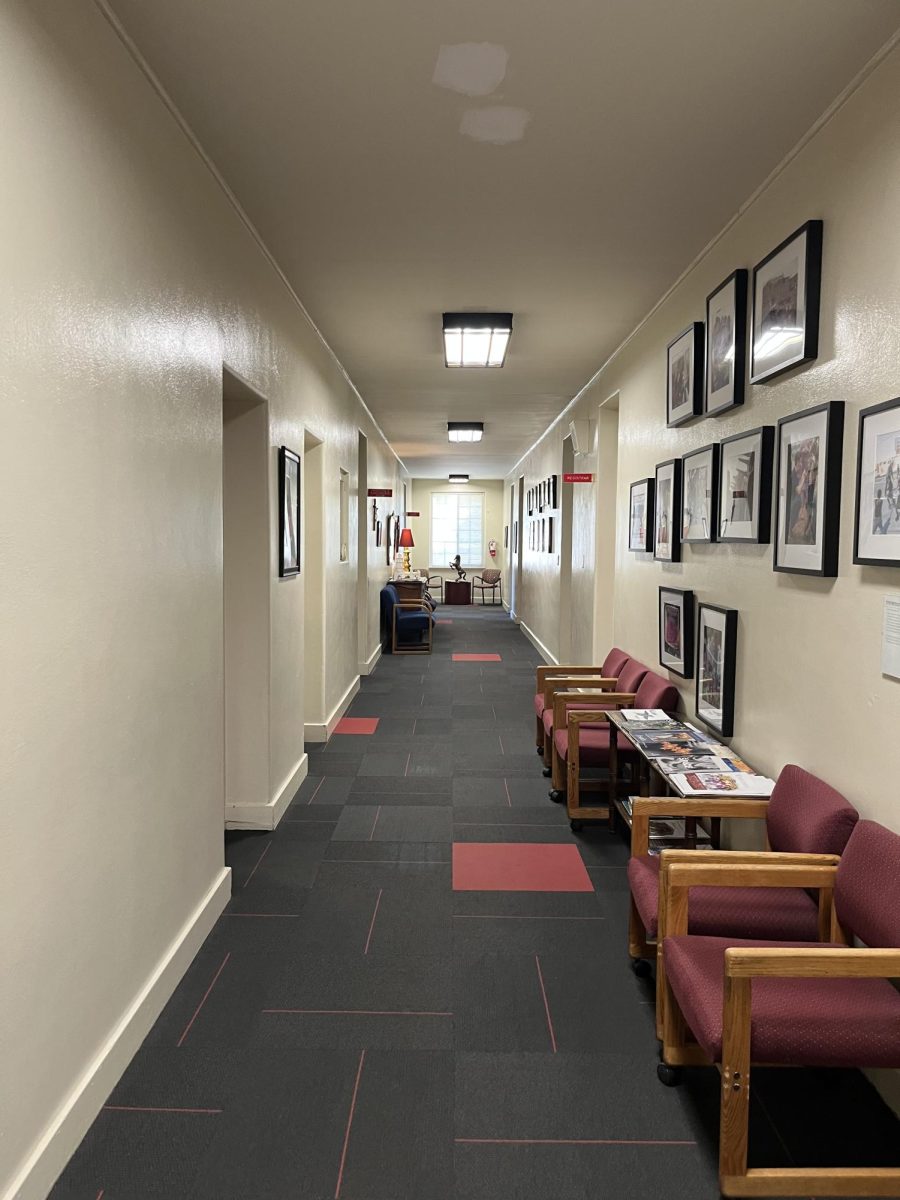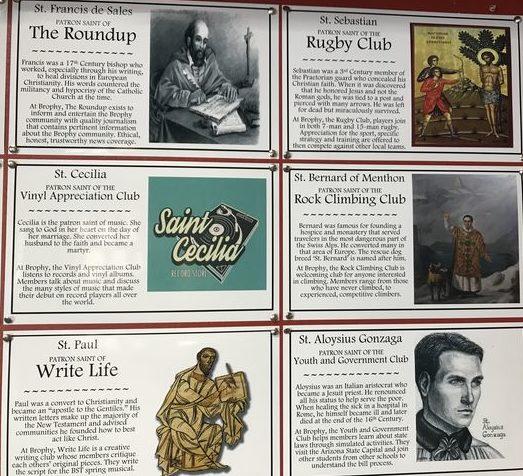Photo by Jackson Moran ’21 | The wall of patron saints outside of the SAC depicts the patrons of numerous clubs.
Jackson Moran ’21
THE ROUNDUP
Last October, as the Catholic feast day of All Saints Day approached, the Office of Faith and Justice (OFJ) sought to bring the lives and message of the saints to clubs.
Wanting to get people more familiar with the saints, the OFJ decided to assign the numerous clubs a Patron Saint that relates back to the club’s interests and message.
Mr. Paul Fisko had the idea for the program while planning for the All Saints Day Mass.
“We thought, ‘is there some way that we could promote the idea of the saints or get people more familiar with the saints,’ last year we did some prayer cards that we gave to everyone,” Mr. Fisko said.
He said that the OFJ tried to find saints that most people were not familiar with, but who had symbols or patronage that students could relate to.
“That was a more general way of getting people to know a saint or two, this way [the Patron Saint program] we could make it more personal to a specific group of people on campus,” Mr. Fisko said.
Shortly thereafter, each club was assigned a saint.
“I went through every one of the clubs and read about them, and when I read their description, I went to Catholic websites or from my own experience of knowing who the patron saint of a particular thing is, and tried to pair them up,” he said.
He said that the Catholic tradition is fun in the way that there is a patron saint for nearly every activity or group of people, making it interesting to discover saints for each club.
Mr. Fisko then made the proposal to each club to take on a patron saint, with a suggestion of a saint that might be a good fit, but allowed feedback from each club as to who their saint was in the end.
For instance, the Rap Club was assigned St. John Chrysostom, but the leaders of the club decided that his message was not conducive to Brophy’s Jesuit message of acceptance.
According to Anderson, St. John Chrysostom, had tones of homophobia and anti-Semitism in his teachings.
“I talked to Mr. Orem, our moderator, about it” said Ari Anderson ’21, one of the leaders of the Rap Club.
“We researched a few guys and he [St. Justin Martyr] came up,” Andersonsaid.
They then designated St. Justin Martyr as their patron saint.
“He’s the patron saint of public speaking, or from what I researched he was very good at proclaiming the Gospel,” he said.
Kino Teens is another club that embraced the program, as the club’s namesake is Father Eusebio Kino, a Jesuit missionary who worked in the Southwest United States and Mexico.
“Kino Border Initiative is a bi-national organization that works in the main area of immigration,” said club leader Alex Zoneriach ’21.
“Our patron saint is Father Kino, and his main mission was in Baja California, where his assignment was to lead the Atonde exhibition to the Baja California Peninsula,” Zoneriach said.
He said that the Jesuit priest’s interactions with the native peoples, being able to communicate and have a relationship with them, was their main reason for choosing his patronage.
“We’ve been really trying to mimic that through Kino Teens about helping migrants, talking to them, and understanding their stories,” Zoneriach said.
“He has become a role model for us and our main goal is to progress that forward through all of the meetings and interactions we have,” he said.
One main theme that has been made evident is that clubs think of the saints more as a name that was given to them.
Most clubs have done little to incorporate these saints into their meetings or activities.
For example, Kino Teens says a prayer during every meeting, but there is no dedication to Fr. Kino.
The Rap club has also not focused much on St. Justin Martyr.
“It doesn’t mean that much, I don’t know if other clubs have focused on it, but we really haven’t,” Anderson said.
He said the club is highly ecumenical, with many members of different faiths from different backgrounds.
“To us he is a name,” Anderson said. “It’s kind of cool, and we do an opening prayer, but it is always ecumenical, so we never pray to a saint.”
The two club leaders came to the agreement that the program is faulty, as they feel they were just given this “thing” with no plan of what to do with it.
“I think it’s an issue with the program itself, and it’s definitely not a reflection of the OFJ or anyone, but there is a flaw regarding the meaning,” Anderson said.
The clubs all enjoyed the idea of having a saint, with Anderson saying it was “dope” to have one, but in practice, the program is ineffective.
Mr. Fisko had some suggestions on how clubs could become more intertwined with their patron saints, hoping to promote the connection between what is done on campus and what the Catholic tradition has to offer.
“Next year what we may do is ask for particular clubs to highlight their saint in some sort of way with a particular activity,” Mr. Fisko said.
He also said that each saint has a feast day.
One thing that he hopes to see happen is clubs going to Mass on or near the saint’s feast day, as a way to celebrate the saint as a group by participating in one of the most faith-based activities.
“This past November I sent out emails to club moderators whose patron saint’s feast day was coming up, and I said to them, ‘Please consider that as a club that you could organize going to Mass,'” Mr. Fisko said.
He wanted to see them coordinate with the celebrant to see if they could read or participate in the mass, somewhat like a mass sponsorship program.
While clubs are currently not taking advantage of the Patron Saints Program, there is potential in the ideals and work of how it could be brought to the clubs more effectively in the future.












